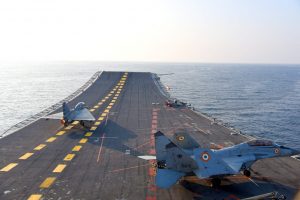The naval version of the Hindustan Aeronautics Limited (HAL) Tejas Light Combat Aircraft (LCA) conducted its first-ever take off and arrested landing from the Indian Navy’s Kiev-class aircraft carrier INS Vikramaditya on January 12, the Indian Ministry of Defense (MoD) announced over the weekend.
The MoD hailed the successful take-off and landing as an “important milestone.” Commodore Jaideep Maolankar did the maiden landing, according to the MoD.
“With the completion of this feat, the indigenously developed niche technologies specific to deck based fighter operations have been proven, which will now pave the way to develop and manufacture the Twin Engine Deck Based Fighter for the Indian Navy, which is expected to proudly fly from the aircraft carriers by the year 2026,” the MoD added.
The Defense Research and Development Organization (DRDO) and the Aeronautical Development Agency (ADA) have been working on a twin-engine medium-weight fighter jet for the Indian Navy’s future carrier force.
Indian Navy Chief Admiral Karambir Singh noted last year that the DRDO has offered to develop such an aircraft based on its experience with the naval variant of the Tejas LCA.
Last November, a Tejas LCA took off for the first time with two beyond visual range (BVR) and two close combat air-to-air missiles (CCM) from the Navy’s Shore Based Test Facility (SBTF) at INS Hansa, located at a naval air station near Dabolim in Goa.
The Indian Navy has repeatedly ruled out the operational deployment of the naval version of the Tejas LCA as a result a number of technical shortcomings including its single engine, as well as excessive weight, which would prevent the fighter jet from carrying an adequate payload when operating from a carrier.
“The Navy has been clear from the very beginning that it needs a twin-engine aircraft and not single-engine because even if an engine fails, the aircraft should be able to land on the carrier,” a Navy source told The Print in December 2019. The new twin-engine variant will reportedly be equipped with the more powerful General Electric F414 afterburning turbofan engine. As I explained previously:
The Tejas requires a short take-off but arrested recovery (STOBAR) configured carrier.
INS Vikramaditya and INS Vikrant, India’s first indigenously built flattop,are both fitted with STOBAR systems for launching aircraft from a ski-jump, whereas the second carrier of the new Vikrant-class, the INS Vishal, will likely use a catapult assisted take-off but arrested recovery (CATOBAR) aircraft launch system, possibly incorporating the new electromagnetic aircraft launch system (EMALS) technology.
Over 50 ski jump take-offs and landings have reportedly been conducted by the naval version of the Tejas LCA at the training facility at INS Hansa in Goa. The first arrested landing was carried out in September 2019.

































